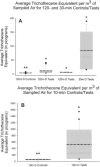Detection of airborne Stachybotrys chartarum macrocyclic trichothecene mycotoxins in the indoor environment
- PMID: 16269780
- PMCID: PMC1287651
- DOI: 10.1128/AEM.71.11.7376-7388.2005
Detection of airborne Stachybotrys chartarum macrocyclic trichothecene mycotoxins in the indoor environment
Abstract
The existence of airborne mycotoxins in mold-contaminated buildings has long been hypothesized to be a potential occupant health risk. However, little work has been done to demonstrate the presence of these compounds in such environments. The presence of airborne macrocyclic trichothecene mycotoxins in indoor environments with known Stachybotrys chartarum contamination was therefore investigated. In seven buildings, air was collected using a high-volume liquid impaction bioaerosol sampler (SpinCon PAS 450-10) under static or disturbed conditions. An additional building was sampled using an Andersen GPS-1 PUF sampler modified to separate and collect particulates smaller than conidia. Four control buildings (i.e., no detectable S. chartarum growth or history of water damage) and outdoor air were also tested. Samples were analyzed using a macrocyclic trichothecene-specific enzyme-linked immunosorbent assay (ELISA). ELISA specificity was tested using phosphate-buffered saline extracts of the fungal genera Aspergillus, Chaetomium, Cladosporium, Fusarium, Memnoniella, Penicillium, Rhizopus, and Trichoderma, five Stachybotrys strains, and the indoor air allergens Can f 1, Der p 1, and Fel d 1. For test buildings, the results showed that detectable toxin concentrations increased with the sampling time and short periods of air disturbance. Trichothecene values ranged from <10 to >1,300 pg/m3 of sampled air. The control environments demonstrated statistically significantly (P < 0.001) lower levels of airborne trichothecenes. ELISA specificity experiments demonstrated a high specificity for the trichothecene-producing strain of S. chartarum. Our data indicate that airborne macrocyclic trichothecenes can exist in Stachybotrys-contaminated buildings, and this should be taken into consideration in future indoor air quality investigations.
Figures



Similar articles
-
Detection of airborne Stachybotrys chartarum macrocyclic trichothecene mycotoxins on particulates smaller than conidia.Appl Environ Microbiol. 2005 Jan;71(1):114-22. doi: 10.1128/AEM.71.1.114-122.2005. Appl Environ Microbiol. 2005. PMID: 15640178 Free PMC article.
-
Detection of trichothecene mycotoxins in sera from individuals exposed to Stachybotrys chartarum in indoor environments.Arch Environ Health. 2004 Jun;59(6):317-23. doi: 10.3200/aeoh.58.6.317-323. Arch Environ Health. 2004. PMID: 16238166
-
Mass spectrometry-based strategy for direct detection and quantification of some mycotoxins produced by Stachybotrys and Aspergillus spp. in indoor environments.Appl Environ Microbiol. 2007 Jul;73(13):4211-7. doi: 10.1128/AEM.00343-07. Epub 2007 May 4. Appl Environ Microbiol. 2007. PMID: 17483261 Free PMC article.
-
Stachybotrys chartarum (chartarum = atra = alternans) and other problems caused by allergenic fungi.Allergy Asthma Proc. 2003 Jan-Feb;24(1):1-7. Allergy Asthma Proc. 2003. PMID: 12635571 Review.
-
The biocontaminants and complexity of damp indoor spaces: more than what meets the eyes.Toxicol Ind Health. 2009 Oct-Nov;25(9-10):583-615. doi: 10.1177/0748233709348386. Epub 2009 Sep 30. Toxicol Ind Health. 2009. PMID: 19793773 Review.
Cited by
-
Mycobiota and mycotoxin-producing fungi in southern California: their colonisation and in vitro interactions.Mycology. 2022 Jul 27;13(4):293-304. doi: 10.1080/21501203.2022.2104950. eCollection 2022. Mycology. 2022. PMID: 36405333 Free PMC article.
-
Mast Cells, Stress, Fear and Autism Spectrum Disorder.Int J Mol Sci. 2019 Jul 24;20(15):3611. doi: 10.3390/ijms20153611. Int J Mol Sci. 2019. PMID: 31344805 Free PMC article. Review.
-
Building-associated neurological damage modeled in human cells: a mechanism of neurotoxic effects by exposure to mycotoxins in the indoor environment.Mycopathologia. 2010 Dec;170(6):377-90. doi: 10.1007/s11046-010-9330-5. Epub 2010 Jun 13. Mycopathologia. 2010. PMID: 20549560
-
Non-Thyroidal Illness Syndrome in Patients Exposed to Indoor Air Dampness Microbiota Treated Successfully with Triiodothyronine.Front Immunol. 2017 Aug 7;8:919. doi: 10.3389/fimmu.2017.00919. eCollection 2017. Front Immunol. 2017. PMID: 28824644 Free PMC article.
-
Growth and mycotoxin production by Chaetomium globosum.Mycopathologia. 2007 Jul;164(1):49-56. doi: 10.1007/s11046-007-9023-x. Epub 2007 Jun 6. Mycopathologia. 2007. PMID: 17551849
References
-
- Barnes, C., S. Buckley, F. Pacheco, and J. Portnoy. 2002. IgE-reactive proteins from Stachybotrys chartarum. Ann. Allergy Asthma Immunol. 89:29-33. - PubMed
-
- Barnes, C., K. Schreiber, F. Pacheco, J. Landuyt, F. Hu, and J. Portnoy. 2000. Comparison of outdoor allergenic particles and allergen levels. Ann. Allergy Asthma Immunol. 84:47-54. - PubMed
-
- Cage, B. R., K. Schreiber, C. Barnes, and J. Portnoy. 1996. Evaluation of four bioaerosol samplers in the outdoor environment. Ann. Allergy Asthma Immunol. 77:401-406. - PubMed
Publication types
MeSH terms
Substances
LinkOut - more resources
Full Text Sources
Other Literature Sources
Medical

